40-Year-Old Single Males, Fivefold Increase Over 20 Years… Intensified Marriage Avoidance Phenomenon
The number of single or unmarried men who have not experienced their first marriage by the age of 40 has nearly quintupled over the past 20 years.
Women are also seeing a rapid increase in the rates of being single or unmarried, but the levels remain lower than those of men.
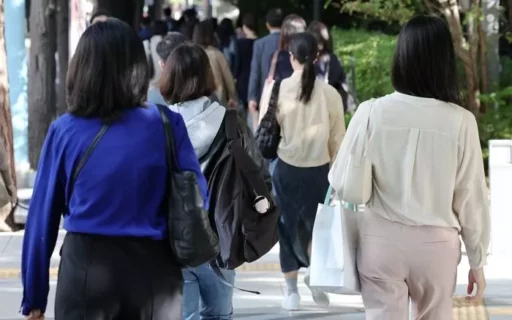
According to the report titled "Cohort Comparison Study on Life Course Transitions: Marriage, Childbirth, Housing," published in the 'SRI Statistical Plus Summer 2025' by the National Statistical Office, the proportion of the population who have not married by age 40 is sharply rising, especially among recent birth cohorts, with a more pronounced trend among men.
For men, the rate of being unmarried at age 40 was only 6.3% for those born in 1960, but rose dramatically to 18.3% for those born in 1970, 25.9% for those born in 1975, and 30.1% for those born in 1980. Similarly, while the rate of women remaining unmarried at age 40 increased significantly from 2.9% among those born in 1960 to 17.2% among those born in 1980, it remained lower compared to men.
Reasons for Marriage Avoidance and Generational Differences in Marriage Intentions
Among young people, the primary reasons for delaying or giving up on marriage were reported as "financial burden for marriage, such as housing" with 35.4% in their 20s and 33.9% in their 30s, the highest proportions. Other main reasons included "burdens of childbirth and child-rearing" and "not feeling the necessity of marriage."
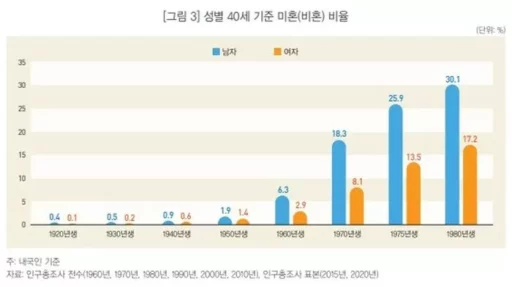
When examining the ages of 24-28, the marriage intention of men born between 1970-1974 was found to be about twice as high compared to those born between 1990-1994.
Across the board, women's marriage intentions were approximately 20 percentage points lower than those of men in all age groups. Additionally, the proportion of women with higher educational attainment than men when marrying has been increasing across all age groups among more recent cohorts.
The fertility rate for women at age 40 has been steadily declining, falling below the population replacement level of 2.1 children since the cohort born in 1960.
The proportion of childless married women at age 40 has quickly risen from 3.0% among those born in 1960 to 9.6% among those born in 1980.
Young People with Higher Education, But Struggling to Find Employment
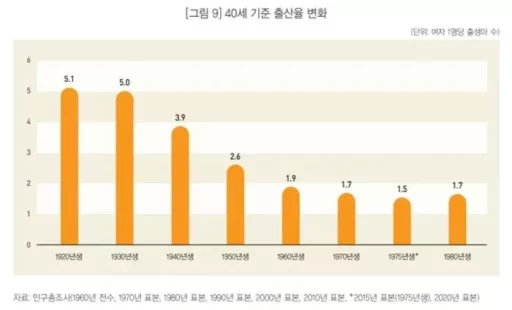
According to the report's authors, Hyeondae Hwan from the National Statistical Office and Professor Kim Geun-tae from Korea University, "The increase in later marriages and non-marriages, which are major causes of low birth rates and aging populations, generally began with the cohort born in the 1970s and has strengthened among those born in the 1980s and later cohorts."
They noted that individuals from the 1970s, often referred to as Generation X, are known for their greater individualistic tendencies and desire for self-development compared to previous cohorts, suggesting that the characteristics of this cohort have coincided with significant societal transformations, leading to the outcomes of later marriages and non-marriages.
According to the report titled "Cohort Comparison of Education and Employment Status Among Youth," while the proportion of college-educated young people has increased among more recent cohorts, the time it takes to secure first employment has actually lengthened.
For the cohort aged 26-30, the proportion of college graduates among those born in 1970-1974 was 41.9%, while for those born in 1985-1989, it surged to 73.1%.
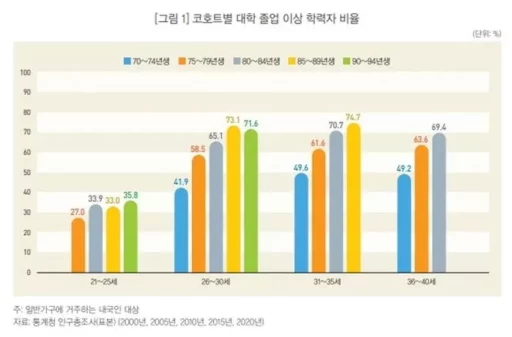
However, the time taken to secure first employment has extended for recent generations, with those aged 25-29 born between 1975-1984 taking an average of 10.7 months, while those born between 1985-1994 took 12.05 months.
The proportion of youth who are not engaged in work or education (NEET) peaks in the late 20s to early 30s across most cohorts.
Although the rate of non-regular employment tends to decrease with age in almost all cohorts, around 40% of those aged 20-24 remain in non-regular jobs, and even for those aged 35-39, 1 in 4 is counted as non-regular.
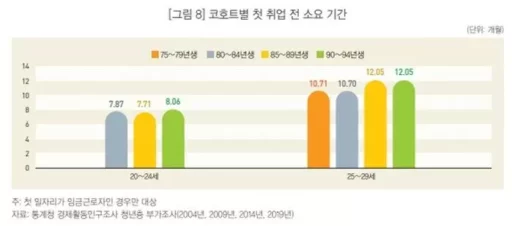
The report's authors, An Sang-keun from the National Statistical Office and Shin Young-kyu from the Korea Institute for Health and Social Affairs, stated, "Even with the expansion of higher education and a noticeable increase in women's educational levels, it is becoming increasingly challenging for the youth to enter the labor market as we move to more recent generations. This suggests that the structure of industries and the labor market is not adequately accommodating youth employment, rather than being an issue of individual educational levels or capabilities."
They further emphasized that "in order to effectively address the increasingly serious youth employment issue as generations pass, we need structural and integrated alternatives rather than fragmented and segmented policies."
Image Source: Research photos for understanding the article / News1, provided by the National Statistical Office.


